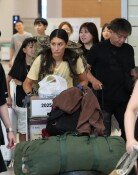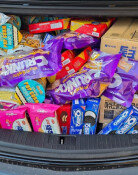Seoul 2nd Most Costly Tourist City
Seoul 2nd Most Costly Tourist City
Posted January. 03, 2007 03:00,
For 2005, the Asia Pacific tourism industry growth rate was 7.8%. While the global village is in fear due to continuous terror attacks and natural disasters, Asia regions tourism industry is growing rapidly, considering that rate is twice as high as the global average of 4%.
The idea that tourism is essential to become a successful city in the 21st Century is spreading in Korea.
The government announced its goal of attracting 10 million tourists in 2010, and Seoul Mayor Oh Se-hoon, who proposed Visit Seoul as his campaign pledge, increased the number to 12 million. 80% of tourists to Korea visit Seoul and it is becoming a tourist city and an important gateway to tourism in Korea.
But the goal does not seem easy to achieve.
The biggest obstacle is daily expenses in Seoul, which rank third after Monte Carlo, Monaco and Paris.
1,000 won difference for Starbucks-
Ohtoya is a fusion restaurant in the New Tokyo building in the center of Tokyo, Japan. As it is popular, it is normal to wait for 10 to 20 minutes during lunchtime before being seated. Having been seated, I ordered the house special Ohtoya lunch (598 yen) and a mackerel meal (640 yen) which added up to 1,238 yen. Applying 100 yen to the 783 won exchange rate, it came to 9,694 won which was less than 10,000 won. With 5,000 won per person, you can enjoy a Japanese white collar salarymans standard lunch.
After lunch, I went to Starbucks which was just across the street and ordered a tall café latte, which costs 3,800 won in Korea. The cost was 360 yen. This came to 2,819 won, a 1,000 won difference.
After three days, I visited a shopping mall food court called Hangtua near Malaysias capital city of Kuala Lumpur. Kuala Lumpur is a big tourism city being visited by 20 million tourists each year and can be compared to the Gangnam area in Seoul. Here, you can have a meal for 1,000 won. Nasijambo (stir-fried rice), Migoraeng (noodle fried to tofu, shrimp and egg) and a drink at Starbucks cost only 5 ringgit (2,499 won).
According to Business Travel News, an American tourism magazine, out of the most expensive 100 global cities, Seoul was ranked number two with $202 just for food expenses a day (business men dining in first class hotels) after worldwide resort Monte-Carlo for 2006. Tokyo came number eight with $158, which is $44 less than Seoul. Kuala Lumpur came number 68 with $75, $127 less than Seoul.
In 2005 daily food expenses in Seoul were $134 (number 23) compared to $156 in Tokyo (number 10). But this has changed in just one year. For hotel accommodation fees, it was $313 for Seoul (number 42) and $456 for Tokyo (number 5) in 2005. However in 2006, Seouls increased by $52 to $365 (number 14) while Tokyos decreased by $72 to $384 (number 9). Kuala Lumpurs accommodation fee decreased form $112 in 2005 to $109 in 2006 and was ranked 100 out of 100 cities.
Cheaper hotels are needed but the land price is too high-
The effect of the weakness of Seoul being too expensive on the tourism industry is directly shown in the number of tourists.
The number of annual tourists to Korea increased only narrowly from 6.02 million in 2005 to 6.15 million in 2006. However, Japan, which had less tourists than Korea, overcame Korea in 2003 and is continuing to increase its number of tourists to 6.73 million in 2005 and 7.3 million in 2006.
Malaysias violence-
Malaysia only had 5 million tourists in 1998. However, this increased to 10.22 million in two years (2000), 13.29 million in 2002, 15.67 million in 2004 and 17.4 million in 2006. Tourists to Malaysia keep on increasing.
Jang Yoo-jae, president of a Changs tourist agency, noted, Chinese tourists visit the most after Japanese, but as Koreas staying expenses are much too high compared to other Southeast Asian countries, it is losing its attractiveness. He added, Korea does not have any outstanding tourism infrastructure or sightseeing experiences to offer.
Samsung Economic Research Institutes researcher Kang Shin-gyeom pointed out that, Although Seouls attempt to lower accommodation fees by lowering various taxes on hotels according to the governments request is helping, it is not a fundamental solution. He went on to say, We need to supply more cheaper hotels with a price around $100. However this is not easy as land prices are too high.
esprit@donga.com







